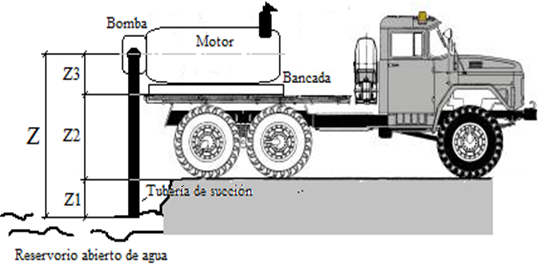Conceptual evaluation determined by NPSH criterion for pump kit installing for alternative firefighting truck
##plugins.themes.bootstrap3.article.main##
Abstract
The mobile technique is an important part of the frefghting process as it allows the transfer of resources, materials and means necessary for the fre control. Usually the vehicles are specialized equipment prepared from the factory to fulfill specialized tasks. Its acquisition is usually expensive. In this work the installation of a pumping group belonging of pumping station, was evaluated on a truck to convert it into a mobile fre-fghting equipment. Due to the head and flow pump requirements were sufficient, their analysis was carried out under the NPSH criterion, which is a requirement so that cavitation does not occur in the pump and its destruction. As result, it was obtained that the analysis technique is correct. However, in the case study it was found that the use of the analyzed pumping group is not recommended for its use under certain conditions as a mobile fire-fighting technique.
Downloads
##plugins.themes.bootstrap3.article.details##

This work is licensed under a Creative Commons Attribution-NonCommercial-ShareAlike 4.0 International License.
References
Pausas, J. G. & Keeley, J. E. (2021). Wildfires and global change. Frontiers in Ecology and the Environment, 19(7), 387-395.
Malik, A. A., Nasif, M. S., Arshad, U., Mokhtar, A. A., Tohir, M. Z. M., & Al-Waked, R. (2023). Predictive Modelling of Wind-Influenced DynamicFire Spread Probability in Tank Farm Due to Domino Effect by Integrating Numerical Simulation with ANN. Fire, 6(3), 85.
Zwierlein, Cornel. The Danger between Nature and Culture: The Quotidian Threat of Urban Fires in the Premodern Era. En Prometheus Tamed. Brill, 2021. pp. 58-240.
Ustinov, A. S., Rogozin, S. S., Pitukhin, E. A. & Astafyeva, M. P. (2021, December). Parameters and operation modes optimization of specialized truck for extinguishing forest fires. In IOP Conference Series: Earth and Environmental Science (Vol. 937, No. 2, pp. 022-028). IOP Publishing.
Patil, H. (2021). Detection, causes and ways of prevention of cavitation in pumps. International Journal of Engineering Applied Sciences and Technology, 6(3), 2455-2143.
Yun, L., Rongsheng, Z., & Dezhong, W. (2020). A cavitation performance prediction method for pumps PART1-Proposal and feasibility. Nuclear Engineering and Technology, 52(11), 2471-2478.
Gopalakrishnan, S. (1985). Modern cavitation criteria for centrifugal pumps. In Proceedings of the 2nd International Pump Symposium. Turbomachinery Laboratories, Department of Mechanical Engineering, Texas A&M University.
KSB. (2016). Omega / Omega V. Characteristic Curves Booklet. KSB Aktiengesellschaft. Frankenthal.
Kallon, D. V., Matlakala, M. E., Nkoana, K. F., Mafu, B. D., & Mkhwanazi, S. B. (2019, October). Effect of Suction Diameter Variations on Performance of Centrifugal Pump. In 2019 Open Innovations (OI) (pp. 170-173). IEEE.

